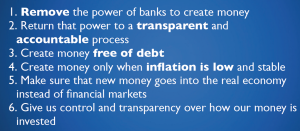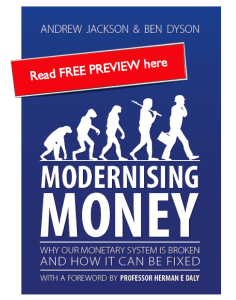Banking Reform – Let’s start at the root


[first]There is a fundamental problem with the system, that cannot be fixed in the long run by looking at superficial symptoms.[/first]
The root of the problem is that private banks are legally allowed to expand the money supply through the issuance of debt.
Positive Money has spent the last couple of years researching the biggest flaws in the banking system, and developing proposals to reform the banking and monetary system. If implemented, these proposals would not only make the banking safer, but also result in many other positive impacts on the wider economy.
The Positive Money reforms would:
1. Create a stable money supply which is not based on debt, not issued by private banks and not dependent on the lending behaviour of banks. Making these changes would protect the economy from the credit bubbles and credit crunches that have caused so many problems over the last few years.
2. Create an economy where entrepreneurs, innovators and the real economy can thrive by – as much as possible – ensuring that investment goes to businesses, science and technology, rather than into asset price bubbles or financial market speculation.
3. Reduce the burden of personal, household and government debt.
4. Re-align risk and reward, so that those who stand to gain from the upside of risky investments also stand to take the downside.
5. Provide a structure of banking that allows banks to fail, no matter their size. With the current structure of banking no large bank can be permitted to fail, as to do so would also bring down the entire payments system, leaving millions of people with no access to money. Of course, the changes outlined actually reduce the likelihood of bank failure, providing additional protection for savers.
The principles of the Positive Money system are as follows:

1. PRIVATE BANKS WILL NO LONGER BE ABLE TO CREATE MONEY
Currently the money that we use for the vast majority of transactions consists of bank deposits created by banks when they make loans. These deposits – the numbers that appear in your bank account – are accounting entries and an accounting liability (like an IOU) from the bank to the customer. Because banks can create these deposits through the accounting process they use when they make loans, it means that most of the money in our economy (over 97%) consists of this bank-issued money. The reform would convert these deposits on banks’ balance sheets into an account held at the Bank of England, in the process turning them from a liability of banks to their customers to a digital equivalent of cash. Instead of a customer’s bank account representing an IOU or promise to pay from the bank, it would represent electronic money held at the Bank of England. As a result of not being able to create demand deposits that can be used as money, banks would lose the ability to create money.
2. MONEY CREATION TO BE GIVEN TO AN ACCOUNTABLE AND TRANSPARENT BODY
The Bank of England would then take over the role of creating the new money that the economy requires each year to run smoothly. The task of deciding how much money will be injected into the economy would be taken by the Money Creation Committee (MCC), which replaces the Bank of England’s existing Monetary Policy Committee. The MCC would be completely separate and insulated from any kind of political control or influence – i.e. the elected government would not be able to specify the quantity of money that should be created, to avoid conflicts of interest and abuse of the power to create money for political ends.
3. MONEY IS ONLY TO BE CREATED WHEN INFLATION IS LOW AND STABLE
The MCC would create money in line with inflation targets set by the government. An increase in inflation above this target would see the MCC lower the amount of money they created, and possibly stop creating money all together.
4. NEWLY CREATED MONEY TO ENTER THE ECONOMY FREE OF ANY CORRESPONDING DEBT
Upon making a decision to increase the money supply, the MCC would authorise the Bank of England to create the new money by increasing the balance of the government’s ‘Central Government Account’. This newly created money would be non-repayable and therefore debt- free. The newly created money would then be added to tax revenue and distributed according to the elected government’s manifesto and priorities.
5. NEWLY CREATED MONEY TO ENTER THROUGH THE REAL ECONOMY INSTEAD OF FINANCIAL MARKETS
Newly created money could be used to increase government spending, to pay down the national debt, reduce taxes or pay a citizens’ dividend. The exact mix of these options would depend entirely on the elected government of the day.
6. BANKS TO GIVE INDIVIDUALS CONTROL OVER HOW THEIR MONEY IS INVESTED
If an individual wants to invest their money (i.e. to lend it to someone else) then they will have the choice, in very broad terms, over where their money is invested. For example, customers may be offered an Investment Account that directs funds to small and medium businesses, or to renewable energy, or to mortgages, etc. The effect is to democratise finance, so that the banks’ investment and lending decisions start to reflect the priorities of their customers and as a result society in general.
Here you can read the proposal for reform of the banking system in Plain English:

A more detailed explanation of the reforms is available in the book MODERNISING MONEY.